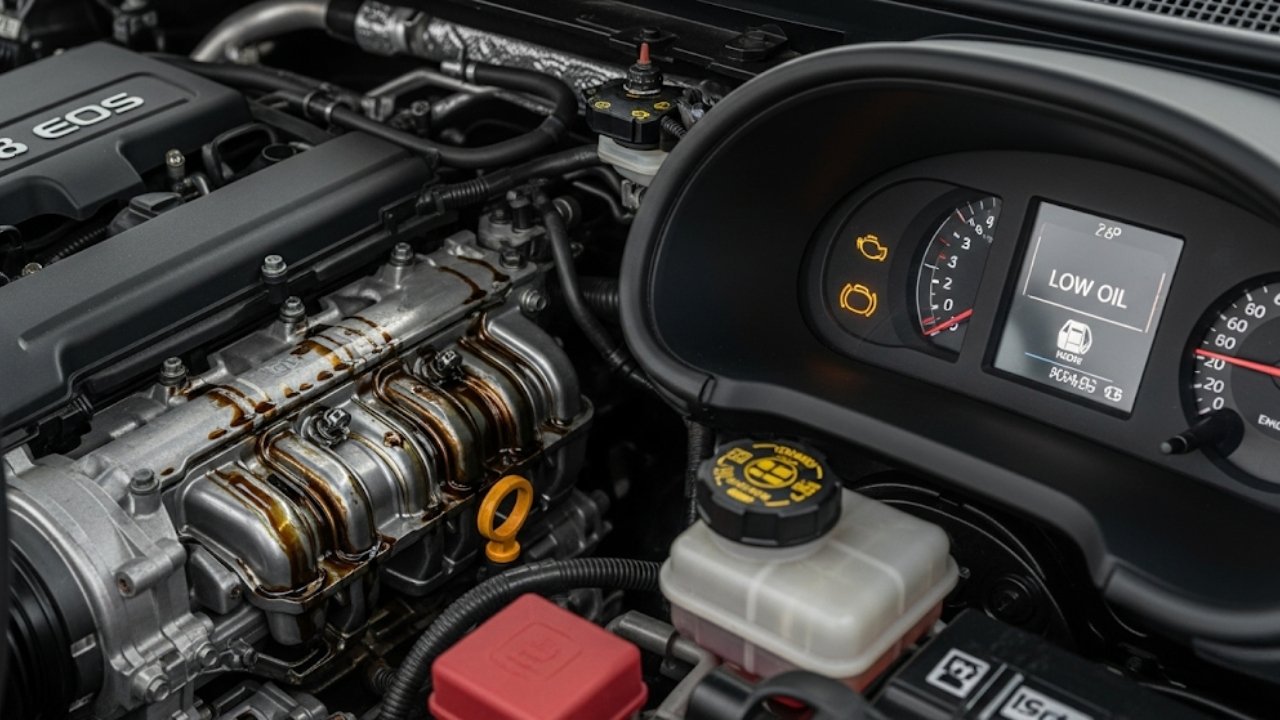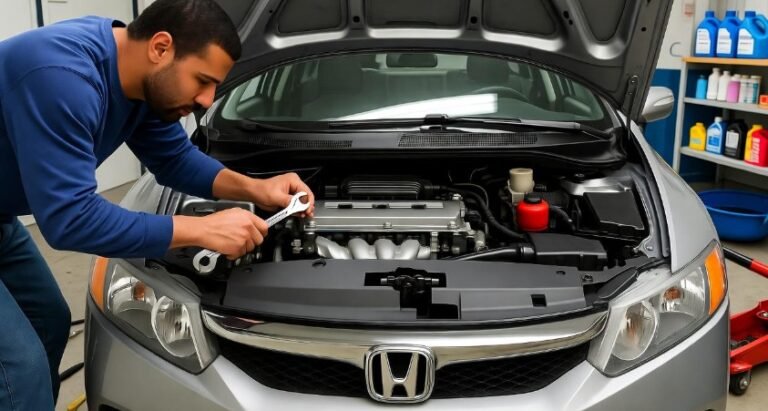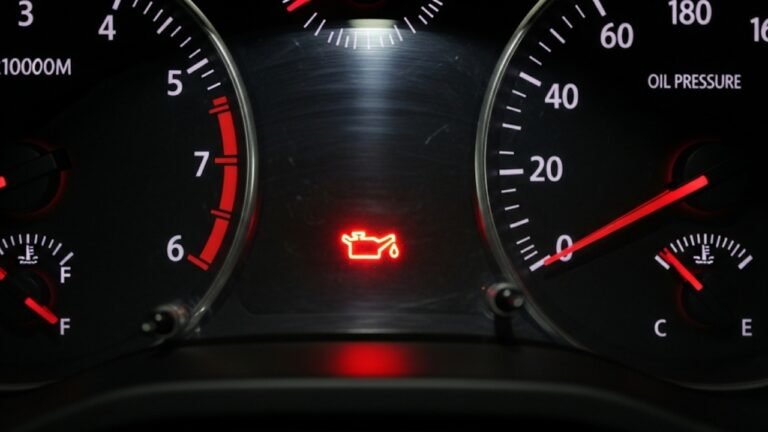What Happens If Your Car Is Low on Oil?

Imagine going for a long run on a hot day, but you haven’t had any water. You’re sweating, breathing heavily, and eventually—your body gives up. That’s exactly what happens to your car when it runs low on oil. Engine oil is like blood to your car. Without it, everything inside the engine starts to grind, overheat, and eventually—fail.
But many people don’t notice when oil is low. It doesn’t shout, “Hey! I’m almost empty!” Instead, it quietly eats away at your engine’s life. I’ve seen people ignore that tiny oil light, only to end up with a seized engine a few weeks later. It’s heartbreaking—and avoidable.
So, what happens if your car is low on oil? Let’s dive in. I’ll walk you through everything—from warning signs to consequences—just like I would tell a close friend who’s about to make a costly mistake.
In This Article
- 1 Why Engine Oil Is More Than Just a Lubricant
- 2 Warning Signs Your Car Is Low on Oil
- 3 The Silent Consequences of Low Oil Levels
- 4 How Low Is Too Low?
- 5 Real-Life Scenarios: What Can Go Wrong
- 6 How to Check Your Engine Oil (and Stay Ahead of Disaster)
- 7 Common Reasons Why Your Car Is Low on Oil
- 8 How to Prevent Low Oil Levels (Simple Habits, Big Savings)
- 9 What to Do If Your Car Is Already Low on Oil
- 10 Emotional Cost: It’s More Than Just Money
- 11 Long-Term Effects of Repeated Low Oil Levels
- 12 FAQs About What Happens If Your Car Is Low on Oil
- 12.1 1. Can I drive short distances if my oil is low?
- 12.2 2. What if my oil light comes on briefly, then goes off?
- 12.3 3. Is synthetic oil better for preventing low oil issues?
- 12.4 4. Can low oil affect fuel economy?
- 12.5 5. Will my car pass inspection with low oil?
- 12.6 6. What if I just changed the oil but the level is low again?
- 12.7 7. Is it normal for cars to lose oil over time?
- 12.8 8. Can I mix different oil brands or types?
- 13 Final Thoughts: A Little Care Goes a Long Way
Why Engine Oil Is More Than Just a Lubricant

What Oil Actually Does:
-
Lubricates metal parts to prevent wear and tear.
-
Cools down the engine by carrying heat away from parts.
-
Cleans the engine by trapping dirt and sludge.
-
Protects against rust and corrosion.
-
Improves fuel efficiency.
Now, imagine all these systems slowing down or stopping just because you’re low on oil. It’s like taking oxygen away from your lungs—you won’t last long.
Warning Signs Your Car Is Low on Oil
I once ignored the signs in my old sedan—thinking I could push it a few more days. Big mistake. The engine started knocking, and that was the beginning of the end.
Here are signs you shouldn’t ignore:
-
Oil warning light on the dashboard
-
Ticking or knocking noises from the engine
-
Burning oil smell inside the cabin
-
Poor fuel economy
-
Overheating engine
-
Visible oil leak under your car
-
Rough idling or stalling
Pro tip: If your car shakes more than usual at stoplights, it’s not nervous—it could be low on oil.
The Silent Consequences of Low Oil Levels
You may not feel the effects instantly, but low oil is like slow poison for your engine.
| Consequence | What Happens | Cost to Fix |
|---|---|---|
| Increased Friction | Metal parts rub, creating wear | $500–$2,000 |
| Overheating | No oil means no heat control | $1,000–$3,500 |
| Engine Seizure | Engine locks up entirely | $3,000–$10,000 |
| Poor Fuel Economy | Engine works harder, burns more fuel | Extra $300/year |
| Shortened Engine Life | Engine wears out years earlier than it should | Total engine cost |
One time, I forgot to top off oil during a cross-country trip. Halfway through, the engine temp soared, and I had to call for a tow in the middle of nowhere. Cost me over $4,000 in repairs—and weeks of regret.
How Low Is Too Low?
You might be wondering, “It’s just a little low—what’s the big deal?”
Here’s the reality:
-
1 quart low = Minor wear increases
-
2 quarts low = Engine starts overheating
-
3 quarts low = Friction damage becomes serious
-
4 quarts low = Risk of complete engine failure
Your engine typically holds 4 to 8 quarts of oil. Losing even 1-2 quarts affects pressure and temperature balance.
Think of it like a dehydrated athlete—performance drops fast, and injury follows.
Real-Life Scenarios: What Can Go Wrong
Let me tell you about a friend of mine, Rafiq. He had a Toyota Corolla, always reliable. One week, he noticed the engine light flickered, but he brushed it off. A week later, while driving in Dhaka traffic, the car stalled. No noise, no warning—just stopped.
Turns out, the engine oil was nearly empty.
The oil filter was clogged, and the engine had seized. Total repair cost? Tk. 250,000.
Stories like this aren’t rare. They’re more common than you think. Most of us don’t check our oil until it’s too late. And that small habit can destroy your entire engine.
How to Check Your Engine Oil (and Stay Ahead of Disaster)
Don’t worry—you don’t need to be a mechanic to check your oil.
Simple Steps:
-
Park on level ground.
-
Let the engine cool for 10 minutes.
-
Pull out the dipstick.
-
Wipe it clean, then reinsert.
-
Pull it out again and check the level.
Look for two marks—low and full. Oil should be in between. If it’s below the lower mark, you need to add oil immediately.
Bonus Tips:
-
Check oil once every two weeks.
-
Always use the recommended oil grade.
-
Keep a quart of spare oil in your trunk.
Trust me, this five-minute check can save you thousands.
Common Reasons Why Your Car Is Low on Oil
Ever wonder why oil levels drop even if you don’t see a leak?
Here are a few hidden culprits:
-
Worn piston rings: Oil burns during combustion.
-
Old valve seals: Oil leaks into cylinders.
-
Clogged PCV valve: Causes internal pressure and leaks.
-
Oil pan damage: Cracks or rust can drip oil.
-
Faulty gaskets: Let oil escape slowly over time.
You might not see puddles under your car, but that doesn’t mean you’re safe. Always check under the hood and around the oil pan for signs.
How to Prevent Low Oil Levels (Simple Habits, Big Savings)
Prevention is always better—and cheaper—than repair. If you’ve ever dealt with a dry engine, you know how painful and costly it can be. But here’s the good news: staying on top of your oil levels doesn’t require fancy tools or deep mechanical knowledge.
Habits That Help:
-
Regular oil changes (every 5,000–7,500 miles or as recommended)
-
Visual checks every 2 weeks
-
Inspect for leaks under the car and around engine parts
-
Use the right oil type and viscosity for your car model
-
Replace your oil filter with every oil change
Most of these take less time than finishing a cup of tea. And trust me, the peace of mind is worth it.
What to Do If Your Car Is Already Low on Oil
So you’ve just checked your dipstick and realized—you’re almost out of oil. Don’t panic. You’ve got options.
Step-by-Step Emergency Fix:
-
Turn off the engine immediately to avoid further damage.
-
Let the engine cool down for 10–15 minutes.
-
Top off with the correct oil grade. (Check your owner’s manual.)
-
Don’t overfill—go slowly and re-check the dipstick after adding.
-
Drive carefully to a mechanic if you notice ongoing issues.
Important Tip:
If your oil light stays on even after topping up, the problem might be deeper—like oil pump failure or internal leaks. Get it inspected ASAP.
I once helped a friend in a remote village who ran out of oil and added cooking oil instead. Please don’t do that. Always keep a spare quart in your trunk—just like keeping an umbrella during monsoon season.
Emotional Cost: It’s More Than Just Money
Here’s something we often overlook—the emotional toll. Imagine breaking down in traffic on a date, with your car spewing smoke and people honking. Embarrassing, right?
Or worse, being stuck at night, far from help, because of a mistake you could’ve avoided with a 5-minute check. The stress, the helplessness, the regret—they stay with you longer than the repair bills.
Taking care of your car’s oil is like self-care. It’s a small act of love for something that takes you places, holds your memories, and sometimes—even saves your life.
Long-Term Effects of Repeated Low Oil Levels
Some folks top up oil without fixing the root cause. That’s like applying cream on a broken leg—it doesn’t heal anything.
Here’s what happens if you frequently run low on oil:
-
Sludge buildup from burnt oil particles
-
Chronic overheating, weakening metal parts
-
⚙️ Premature wear of timing chain and camshaft
-
Oil pump failure, starving the engine entirely
-
Total engine breakdown, even with temporary fixes
The worst part? These damages creep in silently. You might not notice until your engine refuses to start one morning. And by then, it’s already too late.
FAQs About What Happens If Your Car Is Low on Oil
1. Can I drive short distances if my oil is low?
It’s risky. Even short drives with low oil can cause major wear. Always top off before heading out.
2. What if my oil light comes on briefly, then goes off?
That’s your engine begging for help. It’s likely the oil pressure is fluctuating. Check levels immediately.
3. Is synthetic oil better for preventing low oil issues?
Yes, synthetic oil resists breakdown and lasts longer. It also flows better in extreme temperatures.
4. Can low oil affect fuel economy?
Absolutely. Less oil means more friction, which means your engine works harder and burns more fuel.
5. Will my car pass inspection with low oil?
Most likely not. Mechanics check oil levels during basic service inspections.
6. What if I just changed the oil but the level is low again?
That could mean a leak or burning oil internally. Have it checked as soon as possible.
7. Is it normal for cars to lose oil over time?
Yes, especially older engines. Losing a quart every 1,000 miles isn’t uncommon. But anything more should be addressed.
8. Can I mix different oil brands or types?
In an emergency, yes. But regularly mixing oil grades or viscosities can cause performance issues.
Final Thoughts: A Little Care Goes a Long Way
So, what happens if your car is low on oil? A lot—more than most people realize.
It’s not just about fluid levels. It’s about protecting the heart of your vehicle. About being smart today to avoid regret tomorrow. Think of it like brushing your teeth—you don’t wait for cavities to start flossing, right?
Checking your oil is easy, quick, and one of the most loving things you can do for your car. Your engine is counting on you. Don’t let it down.
And next time you hear someone ignoring their oil light, share this article. You might just save their engine—and their wallet.






